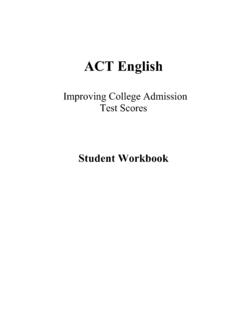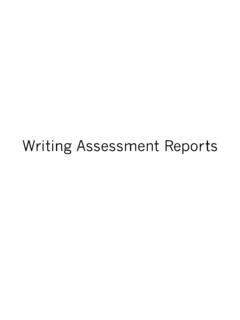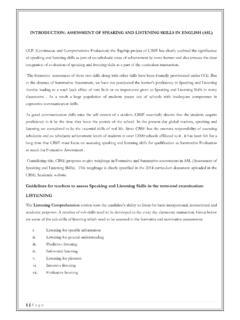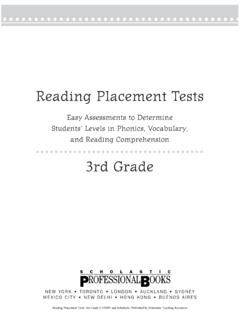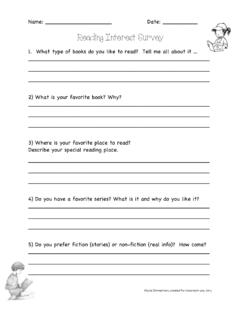Transcription of TORRANCE TESTS OF CREATIVE THINKING
1 TORRANCE TESTSOFCREATIVETHINKINGBy E. Paul TorranceINTERPRETIVE MANUALS cholastic Testing Service, Inc., 480 Meyer Road, Bensenville, Illinois 60106 1617 This booklet is a guide for interpreting results of the TORRANCE TESTS of CREATIVE THINKING (TTCT) Figural and Verbal, Forms A and B. It contains the following:FiguralUnderstanding Figural Assessments of Creativity Separate Norm-Referenced Assessments of Creativity (fluency, originality, abstractness of titles, elaboration, resistance to premature closure) Criterion-Referenced Assessments of Creativity (Checklist of 13 Strengths) Composite Assessments of Creativity (Average Standard Score, Creativity Index)Sample Reports from STS Scoring Service The Individual Student Report The Alphabetical List Report The Group SummaryVerbalUnderstanding Verbal Assessments of Creativity Separate Norm-Referenced Assessments of Creativity (fluency, flexibility, originality) Composite Assessment of Creativity (Average Standard Score)
2 Sample Reports from STS Scoring Service The Individual Student Report The Alphabetical List Report The Group Summary ReportUnderstanding Derived Scores Used in Interpretation of Creativity Assessments Percentile Ranks (National by Grade, National by Age, Local) Normalized Standard ScoresCopyright 2018, scholastic Testing Service, Inc. All rights reserved. No part of this work may be reproduced or transmitted in any form or by any means, electronic or mechanical, including photocopy, recording, or any information storage and retrieval system, without prior permission in writing from the publisher. Published by scholastic Testing Service, Inc., Bensenville, Illinois 60106 1617. Printed in the United States of FIGURAL ASSESSMENTS OF CREATIVITYThe TTCT Figural provides five separate assessments of creativity fluency, originality, abstractness of titles, elaboration, and resistance to premature closure.
3 After making these assessments, the scorer looks for evidence of CREATIVE strengths, thirteen in all, giving ratings of (+) (for 1 or 2 occurrences) or (++) (typically for 3 or more occurrences). Two composite assessments of creativity are then given, the average from the 5 separate assessments, and the Creativity Index (CI) based upon a pooling of results from the separate assessments along with ratings from special CREATIVE strengths. SEPARATE NORM-REFERENCED ASSESSMENTS OF CREATIVITY the following discussions are intended to help understand the five separate assessments of this score is based upon the total number of relevant responses. As such, it is perhaps one of the most critical aspects of the test. All other scores depend in part upon the fluency score inasmuch as no subsequent scores may be given in other dimensions unless a response is first found to be this score is based upon the statistical infrequency and unusualness of the response.
4 As such it indicates whether a student produced a large number of relatively trite, common responses (low originality) or unusual and highly imaginative responses (high originality). Combining two or more figures into a single image is given increased of Titles this score relates to the subject s synthesizing and organizing processes of THINKING . At the highest level, there is the ability to capture the essence of the information involved, to know what is important, and to enable the viewer to see the picture more deeply and the basis of this score is two underlying assumptions: the minimum primary responses to the stimulus figure is a single response; and the imagination and exposition of detail is a function of CREATIVE ability, appropriately labeled to Premature Closure the basis for this score is a person s ability to keep open and delay closure long enough to make the mental leap that makes original ideas possible.
5 Less CREATIVE persons tend to leap to conclusions prematurely without considering the available information, which cuts off chances for more powerful, original ASSESSMENTS OF CREATIVITY the preceding assessments are all norm-referenced, and constitute the primary bases for assessment of creativity. An added thirteen criterion-referenced measures are useful for a more complete overall assessment. These thirteen measures, each yielding scores of (0), (1), or (2), are subsequently pooled with the norm-referenced assessments to provide an overall Creativity Index. This checklist of CREATIVE strengths consists of the following:4 1. Emotional Expressiveness this measures a subject s ability to communicate feelings and emotions verbally or nonverbally through drawings, titles, and speech of the figures in the drawings. 2. Storytelling Articulateness this indicates a subject s ability to clearly and powerfully communicate an idea or tell a story by providing some kind of environment and sufficient detail to put things in context.
6 3. Movement or Action this judges a person s perception of movement through titles and the speech and bodily posture of figures in the drawings. 4. Expressiveness of Titles this notes a person s use of titles that go beyond simple description and communicate something about the pictures that the graphic cues themselves do not express without the title. 5. Synthesis of Incomplete Figures the combination of two or more figures is quite rare and points out an individual whose THINKING departs from the commonplace and established, who is able to see relationships among rather diverse and unrelated elements, and who, under restrictive conditions, utilizes whatever freedom is allowed. 6. Synthesis of Lines (Form A: Circles, Form B) same as 5 above, except combination of sets of parallel lines or combination of circles. 7. Unusual Visualization this measure points out an individual who sees things in new ways as well as old ways and who can return repeatedly to a commonplace object or situation and perceive it in different ways.
7 8. Internal Visualization this measure indicates that a subject is able to visualize beyond exteriors and pay attention to the internal, dynamic workings of things. 9. Extending or Breaking Boundaries this score suggests that a person is able to remain open long enough to permit the mind to make mental leaps away from the obvious and commonplace and to open up or extend the boundaries or limits imposed upon the stimulus figure. 10. Humor this score suggests that an individual perceives and depicts conceptual and perceptual incongruity, unusual combinations, and surprise. 11. Richness of Imagery this score reflects a subject s ability to create strong, sharp, distinct pictures in the mind of the beholder. 12. Colorfulness of Imagery this score reflects a subject s ability to excite and appeal to the senses. 13. Fantasy this measure notes a person s use of fantasy imagery in responding to the test tasks.
8 COMPOSITE ASSESSMENTS OF CREATIVITY some uses of the TTCT require an overall assessment of creativity. The TTCT Figural provides two such measures: the Average Standard Score and Creativity Index. (See page 5 for a detailed explanation.)5 scholastic Testing Service, ,standardscoresarereportedona scalewitha meanof100anda ,percentileranksassociatedwithsuchstanda rdscoresina also been provided for ready comparisons within your theprofileforAbigail. Whileit is logicaltofocusupontheaverage,it is importanttoconsiderallscores,toseewhatth ey tell about the CREATIVE potential of , **isgivenforrepeatedevidenceofa strength(usually3 ormoretimes);a ratingof* is givenforsomeevidence(usually1 or2 times);anda blankis , for Abigail are to the right.**Emotional Expressiveness (in drawings, titles)**Storytelling Articulateness (context, environment)**Movement or action (running, dancing, flying, falling, etc.)
9 Expressiveness of Titles Synthesis of Incomplete Figures (combination of 2 or more) Synthesis of Lines (form A) or Circles (form B) (Combinations)* Unusual Visualization (above, below, at angle, etc.)* Internal Visualization (inside, cross section, etc.)**Extending or Breaking Boundaries**Humor (in titles, captions, drawings, etc.)**Richness of Imagery (variety, vividness, strength, etc.)**Colorfulness of Imagery (excitingness, earthiness, etc.)**Fantasy (figures in myths, fairy tales, science fiction, etc.) ,rawscoresforeachdimensionwithineachacti vityaretotheright. 10 12 1 6 9 2 17 3 5 4 16 Activity 1 Activity 2 Activity 3 FluencyOriginalityTitlesElaborationClosu re* (Bonus is included in Originality Totals)*( )*( )IndividualStudent ReportHill, StormyTorrance TESTS of CREATIVE THINKING (TTCT)Figural Streamlined, Form AOKLAHOMA STATE UNIVERSITYProcNo:17 Grade: 1 Section:08/18/2015 Age: 23 yearsFGender:Codes:Date:Anindex,foundtos ervewellasanoverallindicatorofcreativepo tential, for Stormy is to the Index:89 Natl %-ile:133 Creativity Index:89 Natl %-ile:AGE:GRADE.
10 22595830105 16525410101 19979790138 12858490121 16737350112 858660115 FluencyOriginalityElaborationResistance to Premature ClosureAverageCreativityDimensionNatl%-i leGrdNatl%-ileAgeLocal%-ileGrdStdScoreGr dStandard Score Scale for GradeRawScoreTitles608010012014010410213 8120112115 StdScoreAgeAGE-BASEDGRADE-BASEDC hecklist of CREATIVE StrengthsThe Creativity IndexPart-Score InformationProfile of CREATIVE THINKING Scores52948(10/30/2015 T08-52948-1) SAMPLE SCHOOL ProcNo: 1 2345 Figural Streamlined, Form A TORRANCE TESTS of CREATIVE THINKING (TTCT)Dat e: 08/18/2018Gr ade: 1 7 Section: 1 IndividualSt udent Report Allen, AbigailFIGURAL Individual Student Report* Average Standard Score each of the five norm-refer-enced assessments are reported in terms of a standard score. This enables the averaging of these standard scores to obtain a score reflecting the assessment based upon the pooling of the norm-referenced assessments.

